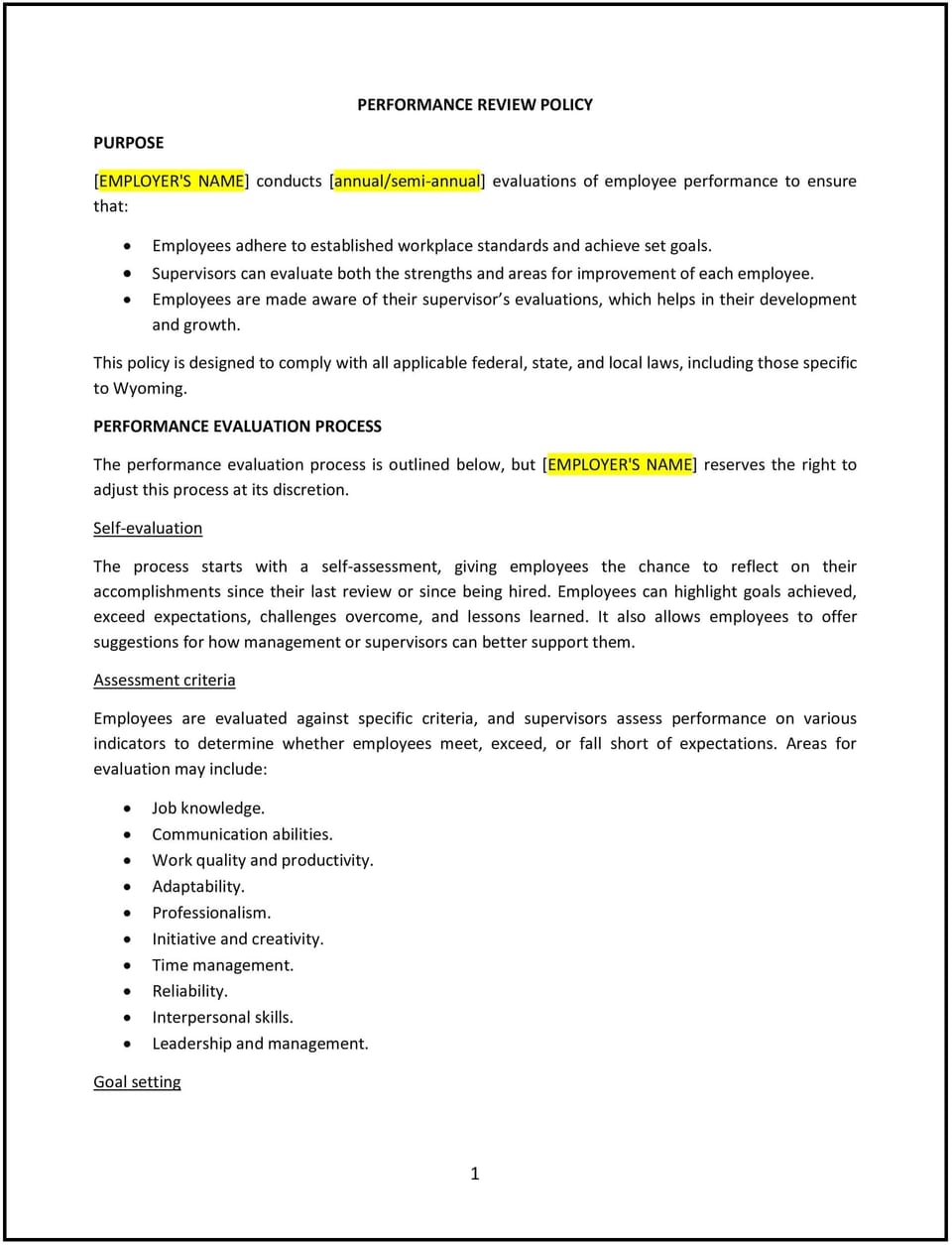Performance review policy (Wyoming): Free template

Performance review policy (Wyoming)
In Wyoming, a performance review policy provides guidelines for evaluating employee performance in a structured and consistent manner. This policy helps businesses identify strengths, address areas for improvement, and align individual contributions with organizational goals.
This policy outlines the frequency, criteria, and procedures for conducting performance reviews, fostering transparency and promoting professional growth.
How to use this performance review policy (Wyoming)
- Define review frequency: Clearly specify how often performance reviews will be conducted, such as annually, semi-annually, or quarterly.
- Outline evaluation criteria: Provide a list of key performance indicators (KPIs) or competencies that will be assessed, such as job knowledge, productivity, teamwork, and communication skills.
- Establish review procedures: Include steps for preparing and conducting reviews, such as setting goals, collecting feedback, and documenting outcomes.
- Encourage employee input: Create opportunities for employees to share their perspectives, set development goals, and discuss career aspirations during reviews.
- Support compliance: Align the policy with Wyoming labor laws and federal regulations to ensure fair and unbiased evaluations.
Benefits of using a performance review policy (Wyoming)
A performance review policy provides several advantages for Wyoming businesses:
- Promotes accountability: Encourages employees to take ownership of their performance and development.
- Supports compliance: Ensures evaluations are conducted fairly and in line with applicable laws and regulations.
- Enhances communication: Fosters open dialogue between employees and managers, strengthening workplace relationships.
- Drives professional growth: Identifies opportunities for training, development, and career advancement.
- Improves organizational alignment: Aligns individual and team performance with company goals and objectives.
Tips for using a performance review policy (Wyoming)
- Train managers: Provide training on effective performance review practices, including giving constructive feedback and setting realistic goals.
- Use standardized tools: Implement consistent evaluation forms or software to ensure fairness and comparability.
- Document thoroughly: Keep detailed records of performance reviews to support decisions related to promotions, raises, or terminations.
- Incorporate 360-degree feedback: Consider gathering feedback from peers, subordinates, and clients to provide a well-rounded evaluation.
- Review periodically: Update the policy to reflect changes in organizational goals or workforce needs.
Q: How often should performance reviews be conducted?
A: The frequency depends on organizational needs, but common intervals include annual, semi-annual, or quarterly reviews.
Q: What should be included in a performance review?
A: Reviews should assess job-specific skills, productivity, teamwork, communication, and goal achievement, among other relevant factors.
Q: How can employees prepare for performance reviews?
A: Employees can prepare by reviewing their goals, accomplishments, and challenges, and by identifying areas where they seek feedback or development.
Q: How does this policy align with Wyoming laws?
A: The policy adheres to employment laws by promoting fairness and avoiding discriminatory practices in evaluations.
Q: How does this policy benefit Wyoming businesses?
A: A performance review policy fosters accountability, professional growth, and organizational alignment, helping businesses achieve long-term success.
This article contains general legal information and does not contain legal advice. Cobrief is not a law firm or a substitute for an attorney or law firm. The law is complex and changes often. For legal advice, please ask a lawyer.


